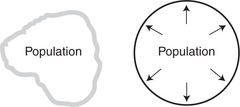CHAPTER 3 Populations
THEORETICAL CONCEPTS OF POPULATIONS
We identify populations based on what we would like to study. A population could be composed of just about anything. It could be wine grapes harvested from a certain county which we would like to taste-test. It could be springs produced in a factory, of which we would like to test the tensile strength. It could be insect eggs or raindrops. It could be children with asthma or women with osteoporosis.
A true population is a theoretical concept. In theory, many populations cannot be counted completely since the number in the collection is extremely large. Take the example of raindrops. If we consider not only all raindrops that are falling at the current time but also those that have fallen in the past, and those yet to come, the true number approaches infinity. Many populations are so huge that it is impossible to account for each member, such as patients with congestive heart failure. A Venn diagram of a large population might have indistinct, muted edges or arrows pointing concentrically away from the center, as in Figure 3-1.
POPULATION PARAMETERS
Every population has attributes we attempt to measure. These are not the same as the characteristics that define the population, although the characteristics and attributes may overlap. The attributes are referred to as parameters. Even though populations are fluid, their attributes are quite stable. For instance, consider the parameter of “average age” in the population of U.S. citizens. If you were able to measure the average age of the population of the United States, it would not vary from day to day, even though many people enter this population through birth and immigration, and many exit through death and change of citizenship. The flux of people entering and exiting the population has a negligible effect on average age. Although populations in themselves can be immeasurable entities, they are very real and their parameters are unyielding. There is an average age of the U.S. population and it does not vary over days or even several weeks, although it may shift gradually over years.
Stay updated, free articles. Join our Telegram channel

Full access? Get Clinical Tree



